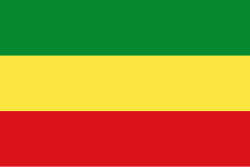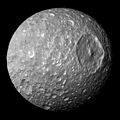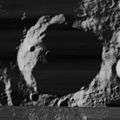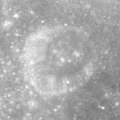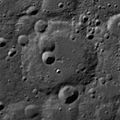In lunar astronomy, libration is the cyclic variation in the apparent position of the Moon that is perceived by observers on the Earth and caused by changes...
15 KB (1,678 words) - 21:38, 25 May 2025
Lagrange point (redirect from Libration point)
mechanics, the Lagrange points (/ləˈɡrɑːndʒ/; also Lagrangian points or libration points) are points of equilibrium for small-mass objects under the gravitational...
51 KB (5,875 words) - 16:48, 22 June 2025
Orbit of the Moon (section Libration)
7° north of the equator and the north pole is visible. This is called libration in latitude. The nodes are points at which the Moon's orbit crosses the...
38 KB (4,679 words) - 21:56, 14 June 2025
In orbital mechanics, a libration point orbit (LPO) is a quasiperiodic orbit around a Lagrange point. Libration is a form of orbital motion exhibited...
3 KB (302 words) - 05:04, 20 October 2024
Libration (from the Latin verb librare "to balance, to sway"; cf. libra "scales") is a type of reciprocating motion in which an object with a nearly fixed...
2 KB (229 words) - 23:24, 14 July 2022
Lunar phase (section Lunar libration)
and perigee requires a more elaborate calculation. Also, due to lunar libration it is not uncommon to see up to 101% of the full moon or even up to 5%...
29 KB (3,036 words) - 08:32, 21 June 2025
of the lunar surface is visible due to cyclical shifts in perspective (libration), making parts of the far side of the Moon visible. The Moon has been...
270 KB (26,448 words) - 18:09, 2 July 2025
Derg (redirect from Socialist Ethiopian Libration Army)
The Derg or Dergue (Amharic: ደርግ, lit. 'committee' or 'council'), officially the Provisional Military Administrative Council (PMAC), was the military junta...
53 KB (5,843 words) - 04:39, 26 May 2025
Libration point orbit – Quasiperiodic orbit around a Lagrange point Robert Farquhar (1966). "Station-Keeping in the Vicinity of Collinear Libration Points...
11 KB (1,131 words) - 07:35, 16 June 2025
crater Herschel was considered to be a more likely explanation for the libration. In 2022, scientists at the Southwest Research Institute identified a...
28 KB (2,706 words) - 13:37, 21 June 2025
looking for a photometrically confirmable concentration of dust at the libration (Lagrangian) points in 1951. After a change in method suggested by Josef...
10 KB (909 words) - 18:30, 28 June 2025
orbit is both somewhat elliptical and inclined to its equatorial plane, libration allows up to 59% of the Moon's surface to be viewed from Earth (though...
9 KB (942 words) - 06:22, 18 June 2025
scientist of his time. Refinements of these laws to include physical librations have been made, and they have been generalized to treat other satellites...
8 KB (992 words) - 07:52, 25 May 2025
appearance, and the location near the limb can limit visibility due to libration. The most favorable time for viewing this feature is near the full moon...
8 KB (587 words) - 14:11, 19 September 2024
last occurred in 1977 (for the American timezones). A small horizontal libration is visible comparing their appearances. By the 19-year metonic cycle the...
40 KB (4,514 words) - 23:10, 11 June 2025
repeated observations from Earth, due to the phenomena of libration and parallax. Librations are primarily caused by the Moon's varying orbital speed due...
47 KB (5,088 words) - 07:37, 11 June 2025
eastern limb of the Moon. The visibility of this formation is affected by libration, and even under favorable conditions it is highly foreshortened. It lies...
5 KB (481 words) - 02:01, 26 January 2024
far side is occasionally visible from Earth due to oscillation and to libration. The remaining 82 percent remained unobserved until 1959, when it was...
40 KB (4,427 words) - 15:55, 16 June 2025
surface is subject to the effects of libration, and the crater can be hidden from sight during an unfavorable libration. Even when visible, however, the crater...
5 KB (391 words) - 02:12, 26 January 2024
Lagrangian points; the average period of their libration is about 150 years. The amplitude of the libration (along the Jovian orbit) varies from 0.6° to...
49 KB (4,618 words) - 12:40, 30 June 2025
Areosynchronous Areostationary Lagrange points Distant retrograde Halo Lissajous Libration Lunar Sun Heliocentric Earth's orbit Mars cycler Heliosynchronous Other...
33 KB (3,236 words) - 12:26, 4 June 2025
side of the Moon, but it is often brought into sight from Earth due to libration. Hume lies just to the west-northwest of the much larger Hirayama, and...
6 KB (434 words) - 02:03, 26 January 2024
that can be viewed. The visibility of this crater is also affected by libration of the Moon. As the eastern rim of Regnault lies across the rim of Volta...
5 KB (439 words) - 02:20, 26 January 2024
Anything past 90°E or 90°W would not be seen from Earth, except for libration, which makes 59% of the Moon visible. Longitude on the Moon is measured...
5 KB (573 words) - 02:09, 19 December 2024
are several classes of co-orbital objects, depending on their point of libration. The most common and best-known class is the trojan, which librates around...
16 KB (1,829 words) - 00:07, 26 June 2025
plutinos) 2:4 Tethys–Mimas (Saturn's moons). Not simplified, because the libration of the nodes must be taken into account. 1:2 Dione–Enceladus (Saturn's...
99 KB (10,602 words) - 07:56, 26 June 2025
foreshortened when viewed from the Earth, and visibility is subject to libration. The outer rim of Gibbs is not quite circular, and an outward bulge to...
6 KB (582 words) - 09:33, 9 March 2025
located near the north pole of the Moon, along the northern limb in the libration zone. It lies just to the south-southeast of the craters Grignard and...
5 KB (398 words) - 02:24, 26 January 2024
eastern limb of the Moon. In this location the crater is subject to lunar libration effects, and appears highly oval due to foreshortening. It is located...
4 KB (342 words) - 01:47, 26 January 2024
this crater is viewed from the side, and the visibility is affected by libration effects. To be viewed in any detail, this crater must be seen or photographed...
6 KB (485 words) - 01:52, 26 January 2024





